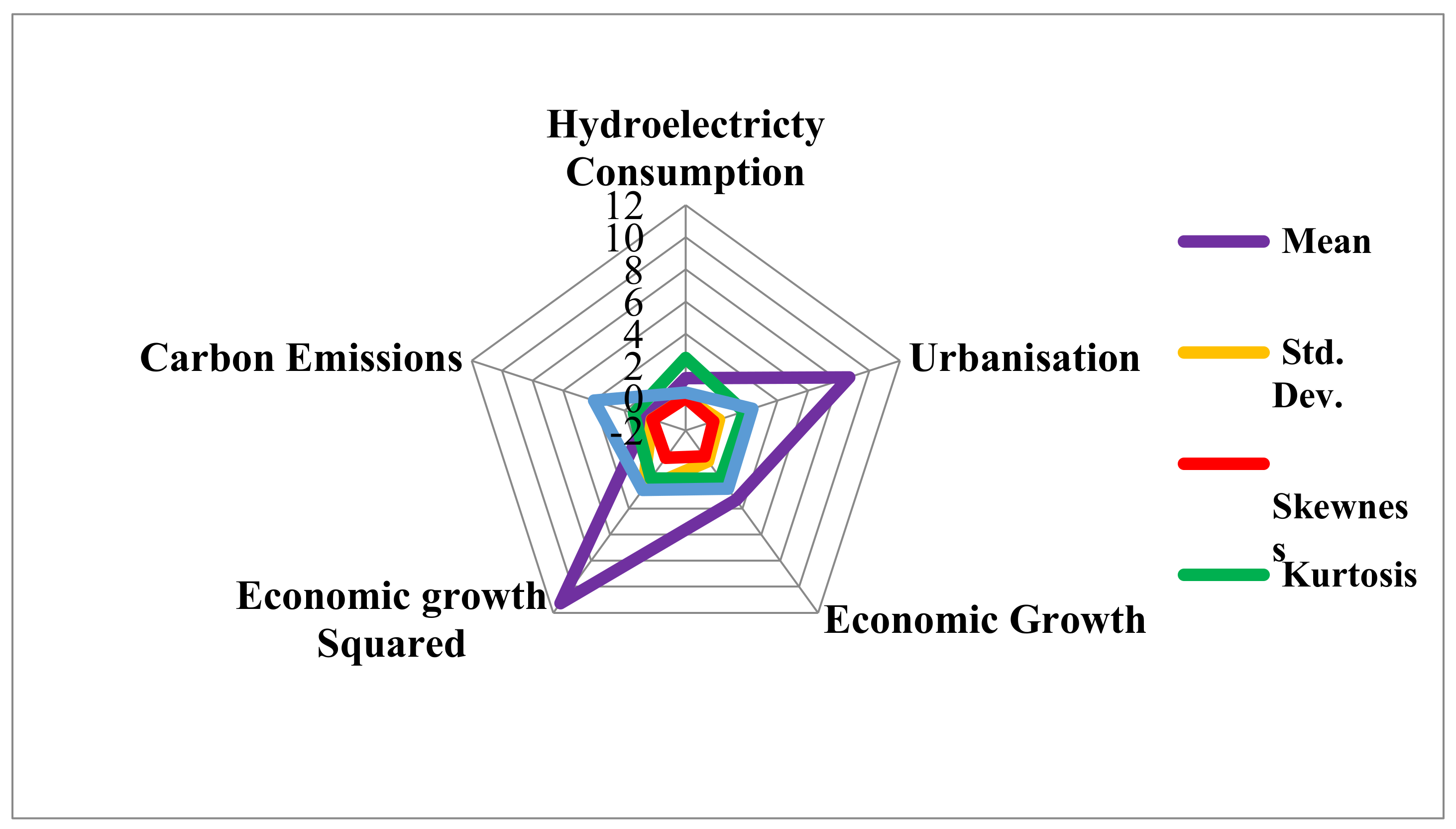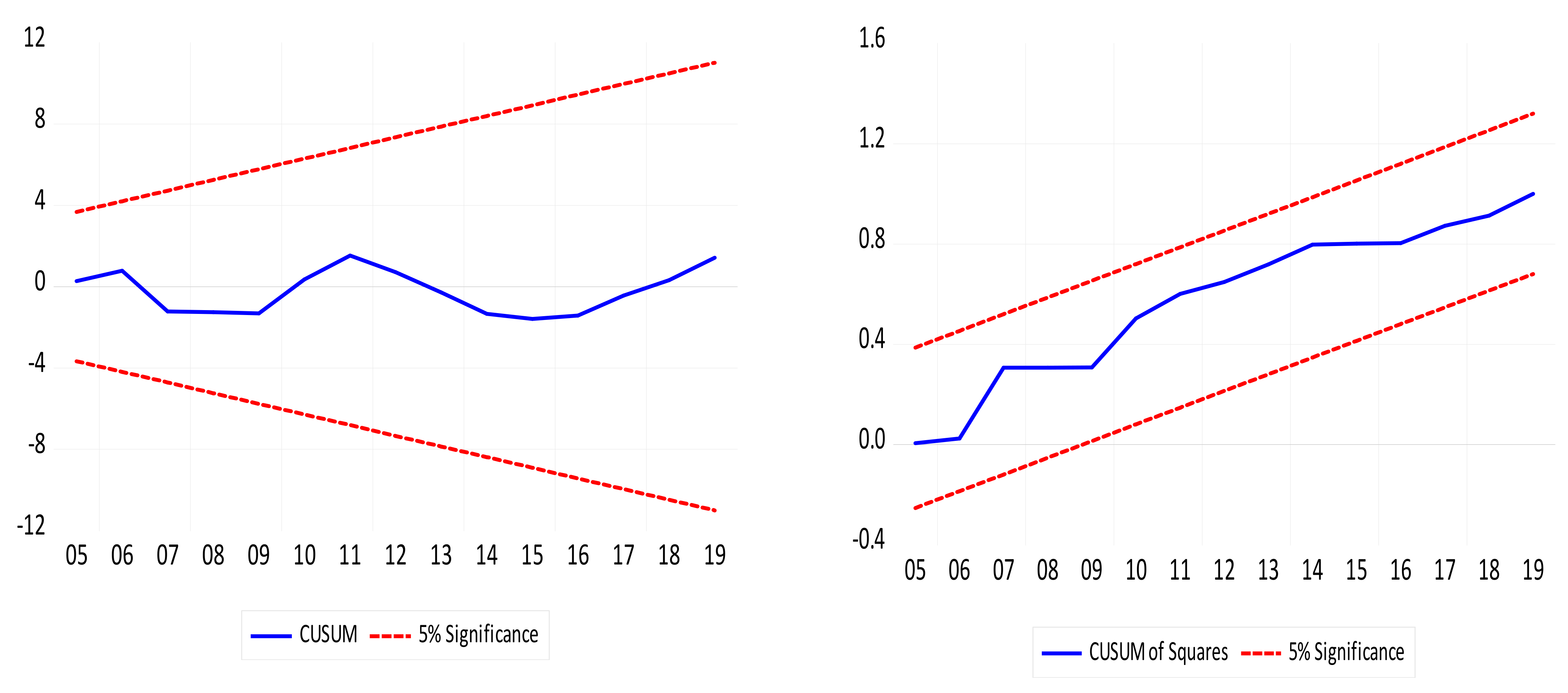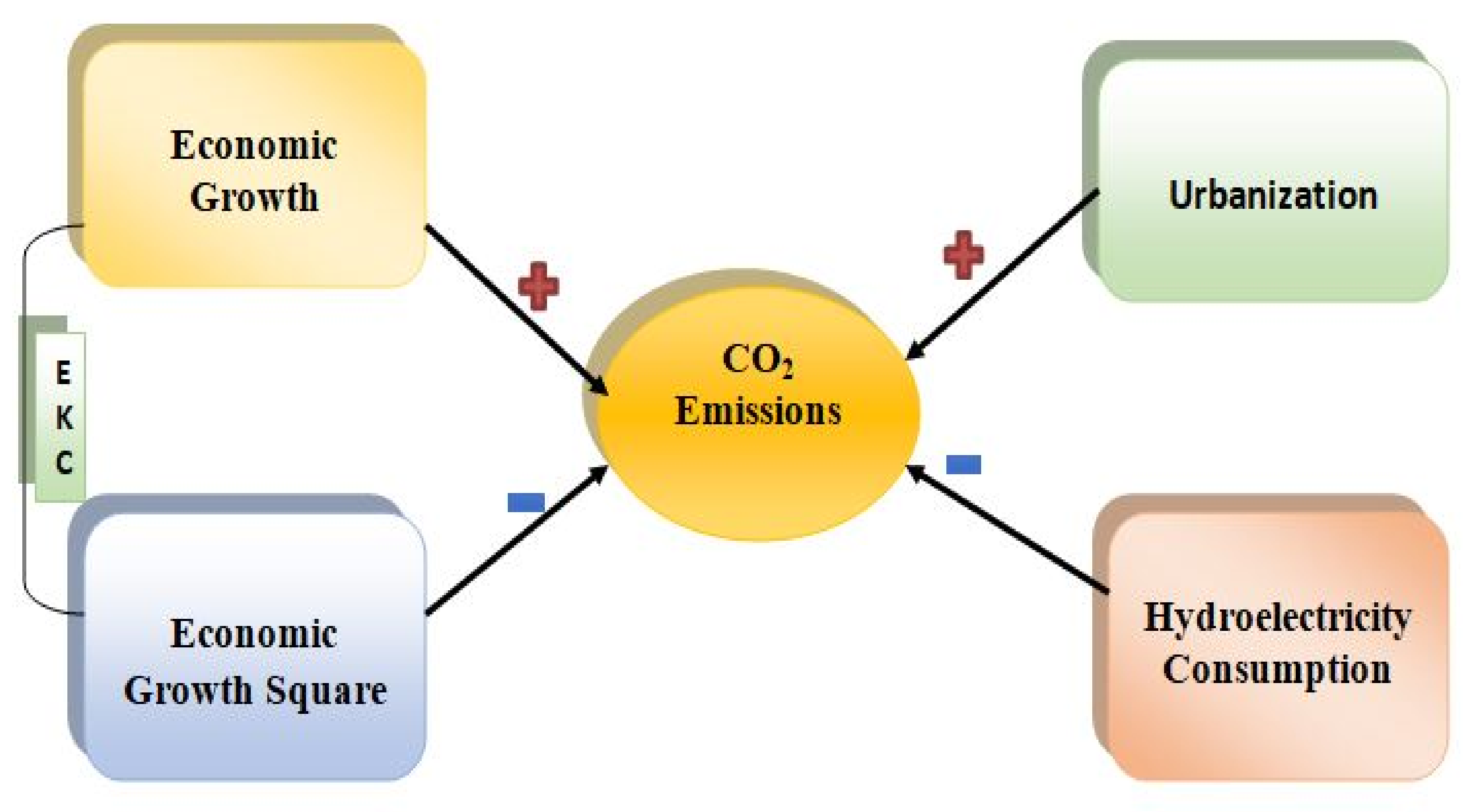Linking Economic Growth, Urbanization, and Environmental Degradation in China: What Is the Role of Hydroelectricity Consumption?
Abstract
:1. Introduction
2. Literature Review
2.1. Theoretical Framework
2.2. Empirical Review
3. Empirical Methodology
4. Results and Discussion
4.1. Findings
4.2. Discussions
5. Conclusions
Author Contributions
Funding
Institutional Review Board Statement
Informed Consent Statement
Data Availability Statement
Conflicts of Interest
References
- Agyekum, E.; Ali, E.; Kumar, N. Clean Energies for Ghana—An Empirical Study on the Level of Social Acceptance of Renewable Energy Development and Utilization. Sustainability 2021, 13, 3114. [Google Scholar] [CrossRef]
- Agyekum, E.B. Techno-economic comparative analysis of solar photovoltaic power systems with and without storage systems in three different climatic regions, Ghana. Sustain. Energy Technol. Assess. 2021, 43, 100906. [Google Scholar] [CrossRef]
- BP Statistical Review—2019. Available online: https://www.bp.com/content/dam/bp/business-sites/en/global/corporate/pdfs/energy-economics/statistical-review/bp-stats-review-2019-china-insights.pdf (accessed on 30 May 2021).
- Umar, M.; Ji, X.; Kirikkaleli, D.; Xu, Q. COP21 Roadmap: Do innovation, financial development, and transportation infrastructure matter for environmental sustainability in China? J. Environ. Manag. 2020, 271, 111026. [Google Scholar] [CrossRef]
- Global Economy. China Percent of World GDP—Data, Chart. TheGlobalEconomyCom. 2021. Available online: https://www.theglobaleconomy.com/china/gdp_share/ (accessed on 31 May 2021).
- EIA. International—U.S. In Energy Information Administration (EIA) 2015. Available online: https://www.eia.gov/international/overview/world?Fips=ch (accessed on 30 May 2021).
- BP. Statistical Review of World Energy 2020. 2021. Available online: https://www.bp.com/content/dam/bp/business-sites/en/global/corporate/pdfs/energy-economics/statistical-review/bp-stats-review-2020-full-report.pdf (accessed on 30 May 2021).
- Agyekum, E.; Adebayo, T.; Bekun, F.; Kumar, N.; Panjwani, M. Effect of Two Different Heat Transfer Fluids on the Performance of Solar Tower CSP by Comparing Recompression Supercritical CO2 and Rankine Power Cycles, China. Energies 2021, 14, 3426. [Google Scholar] [CrossRef]
- Shokri, A.; Heo, E. Energy Policies to promote Renewable Energy Technologies; Learning from Asian Countries Experiences. In Proceedings of the Conference International Association for Energy Economics, Austin, TX, USA, 4–7 November 2012; pp. 1–10. [Google Scholar]
- Orhan, A.; Adebayo, T.; Genç, S.; Kirikkaleli, D. Investigating the Linkage between Economic Growth and Environmental Sustainability in India: Do Agriculture and Trade Openness Matter? Sustainability 2021, 13, 4753. [Google Scholar] [CrossRef]
- Gyamfi, B.A.; Bein, M.A.; Ozturk, I.; Bekun, F.V. The Moderating Role of Employment in an Environmental Kuznets Curve Framework Revisited in G7 Countries. Indones. J. Sustain. Account. Manag. 2020, 4, 241–248. [Google Scholar] [CrossRef]
- Kirikkaleli, D.; Kalmaz, D.B. Testing the moderating role of urbanization on the environmental Kuznets curve: Empirical evidence from an emerging market. Environ. Sci. Pollut. Res. 2020, 27, 38169–38180. [Google Scholar] [CrossRef]
- Soylu, Ö.; Adebayo, T.; Kirikkaleli, D. The Imperativeness of Environmental Quality in China Amidst Renewable Energy Consumption and Trade Openness. Sustainability 2021, 13, 5054. [Google Scholar] [CrossRef]
- Tufail, M.; Song, L.; Adebayo, T.S.; Kirikkaleli, D.; Khan, S. Do fiscal decentralization and natural resources rent curb carbon emissions? Evidence from developed countries. Environ. Sci. Pollut. Res. 2021, 1–12. [Google Scholar] [CrossRef]
- He, X.; Adebayo, T.S.; Kirikkaleli, D.; Umar, M. Consumption-based carbon emissions in Mexico: An analysis using the dual adjustment approach. Sustain. Prod. Consum. 2021, 27, 947–957. [Google Scholar] [CrossRef]
- Kalmaz, D.B.; Kirikkaleli, D. Modeling CO2 emissions in an emerging market: Empirical finding from ARDL-based bounds and wavelet coherence approaches. Environ. Sci. Pollut. Res. 2019, 26, 5210–5220. [Google Scholar] [CrossRef] [PubMed]
- Zhang, L.; Li, Z.; Kirikkaleli, D.; Adebayo, T.S.; Adeshola, I.; Akinsola, G.D. Modeling CO2 emissions in Malaysia: An application of Maki cointegration and wavelet coherence tests. Environ. Sci. Pollut. Res. 2021, 28, 26030–26044. [Google Scholar] [CrossRef]
- Adebayo, T.S.; Akinsola, G.D.; Kirikkaleli, D.; Bekun, F.V.; Umarbeyli, S.; Osemeahon, O.S. Economic performance of Indonesia amidst CO2 emissions and agriculture: A time series analysis. Environ. Sci. Pollut. Res. 2021, 1–15. [Google Scholar] [CrossRef]
- Koengkan, M.; Fuinhas, J.A.; Santiago, R. The relationship between CO2 emissions, renewable and non-renewable energy consumption, economic growth, and urbanisation in the Southern Common Market. J. Environ. Econ. Policy 2020, 9, 383–401. [Google Scholar] [CrossRef]
- Khoshnevis Yazdi, S.; Golestani Dariani, A. CO 2 emissions, urbanisation and economic growth: Evidence from Asian countries. Econ. Res. Ekon. Istraživanja 2019, 32, 510–530. [Google Scholar] [CrossRef] [Green Version]
- Adebayo, T.S.; Akinsola, G.D.; Odugbesan, J.A.; Olanrewaju, V.O. Determinants of Environmental Degradation in Thailand: Empirical Evidence from ARDL and Wavelet Coherence Approaches. Pollution 2021, 7, 181–196. [Google Scholar]
- Jian, J.; Fan, X.; He, P.; Xiong, H.; Shen, H. The Effects of Energy Consumption, Economic Growth and Financial Development on CO2 Emissions in China: A VECM Approach. Sustainability 2019, 11, 4850. [Google Scholar] [CrossRef] [Green Version]
- Charfeddine, L.; Kahia, M. Impact of renewable energy consumption and financial development on CO2 emissions and economic growth in the MENA region: A panel vector autoregressive (PVAR) analysis. Renew. Energy 2019, 139, 198–213. [Google Scholar] [CrossRef]
- Shahbaz, M.; Tiwari, A.; Nasir, M. The effects of financial development, economic growth, coal consumption and trade openness on CO2 emissions in South Africa. Energy Policy 2013, 61, 1452–1459. [Google Scholar] [CrossRef] [Green Version]
- Mutascu, M. A time-frequency analysis of trade openness and CO2 emissions in France. Energy Policy 2018, 115, 443–455. [Google Scholar] [CrossRef]
- Adebayo, T.S.; Kirikkaleli, D.; Adeshola, I.; Oluwajana, D.; Akinsola, G.D.; Osemeahon, O.S. Coal Consumption and Environmental Sustainability in South Africa: The role of Financial Development and Globalization. Int. J. Renew. Energy Dev. 2021, 10, 527–536. [Google Scholar] [CrossRef]
- Lv, Z.; Xu, T. Trade openness, urbanization and CO2 emissions: Dynamic panel data analysis of middle-income countries. J. Int. Trade Econ. Dev. 2018, 28, 317–330. [Google Scholar] [CrossRef]
- Dauda, L.; Long, X.; Mensah, C.N.; Salman, M.; Boamah, K.B.; Ampon-Wireko, S.; Dogbe, C.S.K. Innovation, trade openness and CO2 emissions in selected countries in Africa. J. Clean. Prod. 2021, 281, 125143. [Google Scholar] [CrossRef]
- Adebayo, T.S.; Awosusi, A.A.; Kirikkaleli, D.; Akinsola, G.D.; Mwamba, M.N. Can CO2 emissiovns and energy consumption determine the economic performance of South Korea? A time series analysis. Environ. Sci. Pollut. Res. 2021, 1–16. [Google Scholar]
- Solarin, S.A.; Al-Mulali, U.; Ozturk, I. Validating the environmental Kuznets curve hypothesis in India and China: The role of hydroelectricity consumption. Renew. Sustain. Energy Rev. 2017, 80, 1578–1587. [Google Scholar] [CrossRef]
- Dogan, E.; Inglesi-Lotz, R. The impact of economic structure to the environmental Kuznets curve (EKC) hypothesis: Evidence from European countries. Environ. Sci. Pollut. Res. 2020, 27, 12717–12724. [Google Scholar] [CrossRef]
- Adebayo, T.S.; Kirikkaleli, D. Impact of renewable energy consumption, globalization, and technological innovation on en-vironmental degradation in Japan: Application of wavelet tools. Environ. Dev. Sustain. 2021. [Google Scholar] [CrossRef]
- Adedoyin, F.F.; Alola, A.A.; Bekun, F.V. An assessment of environmental sustainability corridor: The role of economic expansion and research and development in EU countries. Sci. Total Environ. 2020, 713, 136726. [Google Scholar] [CrossRef]
- Shahbaz, M.; Balsalobre-Lorente, D.; Sinha, A. Foreign direct Investment–CO2 emissions nexus in Middle East and North African countries: Importance of biomass energy consumption. J. Clean. Prod. 2019, 217, 603–614. [Google Scholar] [CrossRef] [Green Version]
- Kirikkaleli, D. New insights into an old issue: Exploring the nexus between economic growth and CO2 emissions in China. Environ. Sci. Pollut. Res. 2020, 27, 1–10. [Google Scholar] [CrossRef]
- Umar, M.; Ji, X.; Kirikkaleli, D.; Alola, A.A. The imperativeness of environmental quality in the United States transportation sector amidst biomass-fossil energy consumption and growth. J. Clean. Prod. 2021, 285, 124863. [Google Scholar] [CrossRef]
- Solarin, S.A.; Ozturk, I. On the causal dynamics between hydroelectricity consumption and economic growth in Latin America countries. Renew. Sustain. Energy Rev. 2015, 52, 1857–1868. [Google Scholar] [CrossRef]
- Apergis, N.; Chang, T.; Gupta, R.; Ziramba, E. Hydroelectricity consumption and economic growth nexus: Evidence from a panel of ten largest hydroelectricity consumers. Renew. Sustain. Energy Rev. 2016, 62, 318–325. [Google Scholar] [CrossRef] [Green Version]
- Gyamfi, B.A.; Bein, M.A.; Bekun, F.V. Investigating the nexus between hydroelectricity energy, renewable energy, nonrenewable energy consumption on output: Evidence from E7 countries. Environ. Sci. Pollut. Res. 2020, 27, 25327–25339. [Google Scholar] [CrossRef]
- Adebayo, T.S.; Udemba, E.N.; Ahmed, Z.; Kirikkaleli, D. Determinants of consumption-based carbon emissions in Chile: An application of non-linear ARDL. Environ. Sci. Pollut. Res. 2021, 1–15. [Google Scholar] [CrossRef]
- Ridzuan, A.R.; Albani, A.; Latiff, A.R.A.; Razak, M.I.M.; Murshidi, M.H. The Impact of Energy Consumption Based on Fossil Fuel and Hydroelectricity Generation towards Pollution in Malaysia, Indonesia And Thailand. Int. J. Energy Econ. Policy 2020, 10, 215–227. [Google Scholar] [CrossRef]
- Kivyiro, P.; Arminen, H. Carbon dioxide emissions, energy consumption, economic growth, and foreign direct investment: Causality analysis for Sub-Saharan Africa. Energy 2014, 74, 595–606. [Google Scholar] [CrossRef]
- Pesaran, M.H.; Shin, Y.; Smithc, R.J. Bounds testing approaches to the analysis of level relationships. J. Appl. Econ. 2001, 16, 289–326. [Google Scholar] [CrossRef]
- Nazlioglu, S.; Gormus, N.A.; Soytas, U. Oil prices and real estate investment trusts (REITs): Gradual-shift causality and volatility transmission analysis. Energy Econ. 2016, 60, 168–175. [Google Scholar] [CrossRef]
- Hatemi-J, A.; Irandoust, M. On the Causality Between Exchange Rates and Stock Prices: A Note. Bull. Econ. Res. 2002, 54, 197–203. [Google Scholar] [CrossRef]
- Balcilar, M.; Ozdemir, Z.A.; Arslanturk, Y. Economic growth and energy consumption causal nexus viewed through a bootstrap rolling window. Energy Econ. 2010, 32, 1398–1410. [Google Scholar] [CrossRef]
- Zivot, E.; Andrews, D.W.K. Further Evidence on the Great Crash, the Oil-Price Shock, and the Unit-Root Hypothesis. J. Bus. Econ. Stat. 2002, 20, 25–44. [Google Scholar] [CrossRef]
- Adebayo, T.S.; Kalmaz, D.B. Ongoing Debate Between Foreign Aid and Economic Growth in Nigeria: A Wavelet Analysis. Soc. Sci. Q. 2020, 101, 2032–2051. [Google Scholar] [CrossRef]
- Wang, K.-H.; Liu, L.; Adebayo, T.S.; Lobon, O.-R.; Claudia, M.N. Fiscal decentralization, political stability and resources curse hypothesis: A case of fiscal decentralized economies. Resour. Policy 2021, 72, 102071. [Google Scholar] [CrossRef]
- Enders, W.; Lee, J. A Unit Root Test Using a Fourier Series to Approximate Smooth Breaks*. Oxf. Bull. Econ. Stat. 2011, 74, 574–599. [Google Scholar] [CrossRef] [Green Version]
- Bibi, F.; Jamil, M. Testing environment Kuznets curve (EKC) hypothesis in different regions. Environ. Sci. Pollut. Res. 2021, 28, 13581–13594. [Google Scholar] [CrossRef]
- Murshed, M.; Ali, S.R.; Banerjee, S. Consumption of liquefied petroleum gas and the EKC hypothesis in South Asia: Evidence from cross-sectionally dependent heterogeneous panel data with structural breaks. Energy Ecol. Environ. 2021, 6, 353–377. [Google Scholar] [CrossRef]
- Pata, U.K.; Aydin, M. Testing the EKC hypothesis for the top six hydropower energy-consuming countries: Evidence from Fourier Bootstrap ARDL procedure. J. Clean. Prod. 2020, 264, 121699. [Google Scholar] [CrossRef]
- Akadırı, S.S.; Alola, A.A.; Usman, O. Energy mix outlook and the EKC hypothesis in BRICS countries: A perspective of economic freedom vs. economic growth. Environ. Sci. Pollut. Res. 2021, 28, 8922–8926. [Google Scholar] [CrossRef]
- Al-Mulali, U.; Ozturk, I.; Lean, H.H. The influence of economic growth, urbanization, trade openness, financial development, and renewable energy on pollution in Europe. Nat. Hazards 2015, 79, 621–644. [Google Scholar] [CrossRef]
- Al-Mulali, U.; Saboori, B.; Ozturk, I. Investigating the environmental Kuznets curve hypothesis in Vietnam. Energy Policy 2015, 76, 123–131. [Google Scholar] [CrossRef]
- Govindaraju, V.G.R.C.; Tang, C.F. The dynamic links between CO2 emissions, economic growth and coal consumption in China and India. Appl. Energy 2013, 104, 310–318. [Google Scholar] [CrossRef]
- Rjoub, H.; Odugbesan, J.A.; Adebayo, T.S.; Wong, W.-K. Sustainability of the Moderating Role of Financial Development in the Determinants of Environmental Degradation: Evidence from Turkey. Sustainability 2021, 13, 1844. [Google Scholar] [CrossRef]
- Tiwari, A.K.; Shahbaz, M.; Hye, Q.M.A. The environmental Kuznets curve and the role of coal consumption in India: Cointe-gration and causality analysis in an open economy. Renew. Sustain. Energy Rev. 2013, 18, 519–527. [Google Scholar] [CrossRef] [Green Version]
- Wang, S.; Zhou, D.; Zhou, P.; Wang, Q. CO2 emissions, energy consumption and economic growth in China: A panel data analysis. Energy Policy 2011, 39, 4870–4875. [Google Scholar] [CrossRef]
- Zhang, X.-P.; Cheng, X.-M. Energy consumption, carbon emissions, and economic growth in China. Ecol. Econ. 2009, 68, 2706–2712. [Google Scholar] [CrossRef]
- CSIS. How Is China’s Energy Footprint Changing?|ChinaPower Project n.d. Available online: https://chinapower.csis.org/energy-footprint/ (accessed on 30 May 2021).
- World Bank. World Development Indicators. Washington 2015. Available online: https://datacatalog.worldbank.org/ (accessed on 30 May 2021).




| Level | First Difference | |||
|---|---|---|---|---|
| t-Statistic | Break Date | t-Statistic | Break Date | |
| CO2 | −3.368 | 1996 | −5.700 * | 2002 |
| URB | −1.752 | 2004 | −6.028 * | 2001 |
| GDP | −4.217 | 2009 | −5.293 ** | 2005 |
| GDP2 | −4.192 | 1995 | −5.804 ** | 2008 |
| HYDRO | −4.032 | 2012 | −5.835 * | 2012 |
| F-Statistics | 6.76 * | |||||
| Break Date | 2002 | |||||
| Cointegration | Yes | |||||
| 10% | 5% | 1% | ||||
| F-statistics CV | 2.204 | 3.320 | 2.615 | 3.891 | 3.572 | 5.112 |
| Long-Run Outcomes | Short-Run Outcomes | |||||
|---|---|---|---|---|---|---|
| Regressors | Coefficient | T-Statistics | p-Value | Coefficient | T-Statistics | p-Value |
| GDP | 10.176 ** | 2.2101 | 0.0411 | 6.7884 * | 3.8516 | 0.0013 |
| GDP2 | −1.5234 *** | −2.0772 | 0.0533 | −1.0392 * | −3.6959 | 0.0018 |
| URB | 4.9196 * | 3.1177 | 0.0063 | 4.792 * | 6.0073 | 0.0000 |
| HYDRO | −0.1240 *** | −1.8521 | 0.0815 | −0.2359 * | −4.3852 | 0.0005 |
| BD | 0.0158 | 1.4209 | 0.1734 | 0.2039 *** | 1.8096 | 0.0904 |
| ECMt−1 | −0.625* | −8.5033 | 0.0000 | |||
| Diagnostic Tests | ||||||
| R2 | 0.99 | |||||
| Adj R2 | 0.98 | |||||
| χ2 ARCH | 0.933 (0.555) | |||||
| χ2 RESET | 0.761 (0.458) | |||||
| χ2 Normality | 0.515 (0.772) | |||||
| χ2 LM | 2.041 (0.174) | |||||
| Dependent Variable | CO2 | GDP | GDP2 | URB | HYDRO |
|---|---|---|---|---|---|
| CO2 | 1 | 20.070 * | 18.622 * | 7.4364 | 14.310 ** |
| GDP | 16.563 ** | 1 | 15.904 ** | 11.040 | 22.277 * |
| GDP2 | 2.8363 | 16.224 ** | 1 | 14.945 ** | 23.781 * |
| URB | 59.597 * | 13.566 *** | 13.550 ** | 1 | 38.204 * |
| HYDRO | 21.584 * | 23.651 * | 17.812 ** | 8.176028 | 1 |
Publisher’s Note: MDPI stays neutral with regard to jurisdictional claims in published maps and institutional affiliations. |
© 2021 by the authors. Licensee MDPI, Basel, Switzerland. This article is an open access article distributed under the terms and conditions of the Creative Commons Attribution (CC BY) license (https://creativecommons.org/licenses/by/4.0/).
Share and Cite
Adebayo, T.S.; Agboola, M.O.; Rjoub, H.; Adeshola, I.; Agyekum, E.B.; Kumar, N.M. Linking Economic Growth, Urbanization, and Environmental Degradation in China: What Is the Role of Hydroelectricity Consumption? Int. J. Environ. Res. Public Health 2021, 18, 6975. https://doi.org/10.3390/ijerph18136975
Adebayo TS, Agboola MO, Rjoub H, Adeshola I, Agyekum EB, Kumar NM. Linking Economic Growth, Urbanization, and Environmental Degradation in China: What Is the Role of Hydroelectricity Consumption? International Journal of Environmental Research and Public Health. 2021; 18(13):6975. https://doi.org/10.3390/ijerph18136975
Chicago/Turabian StyleAdebayo, Tomiwa Sunday, Mary Oluwatoyin Agboola, Husam Rjoub, Ibrahim Adeshola, Ephraim Bonah Agyekum, and Nallapaneni Manoj Kumar. 2021. "Linking Economic Growth, Urbanization, and Environmental Degradation in China: What Is the Role of Hydroelectricity Consumption?" International Journal of Environmental Research and Public Health 18, no. 13: 6975. https://doi.org/10.3390/ijerph18136975
APA StyleAdebayo, T. S., Agboola, M. O., Rjoub, H., Adeshola, I., Agyekum, E. B., & Kumar, N. M. (2021). Linking Economic Growth, Urbanization, and Environmental Degradation in China: What Is the Role of Hydroelectricity Consumption? International Journal of Environmental Research and Public Health, 18(13), 6975. https://doi.org/10.3390/ijerph18136975










